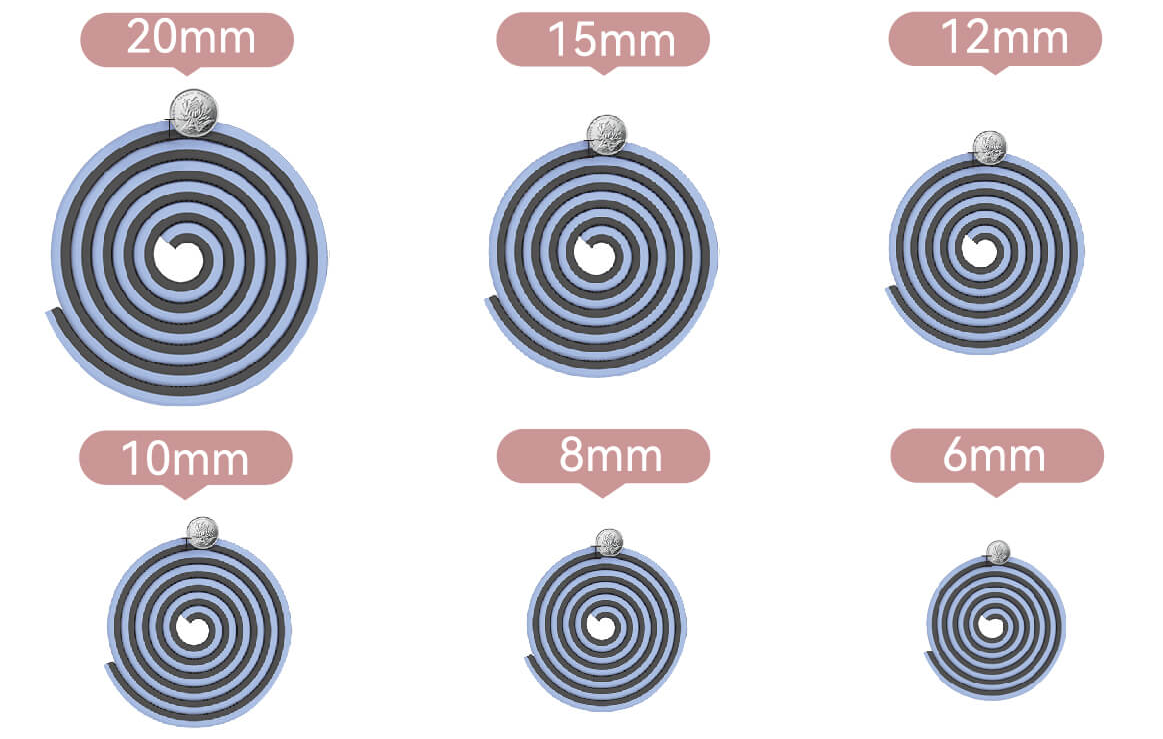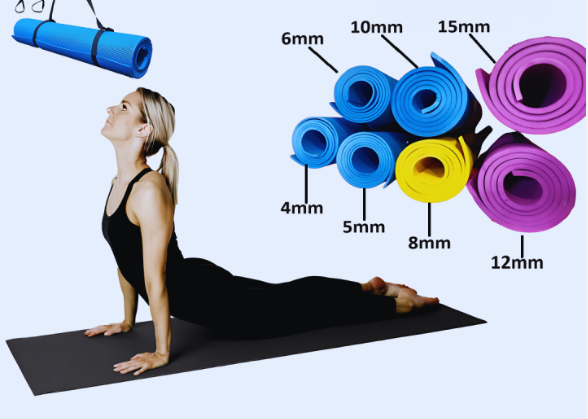I know, choosing an exercise mat sounds like a simple task. From my experience, the thickness you pick is key. It makes a real difference to your comfort and how well you can perform your exercises. Have your knees ever ached after a yoga session? Or perhaps you’ve struggled to keep your balance during a workout? I believe the thickness of your mat can change so much. Still, I see most people just grab the first one they find. But I think picking the mat that suits you isn’t as easy as it looks…

Understanding Exercise Mat Thickness
I believe picking the right exercise mat thickness is very important. It helps you get the most out of your workouts and yoga. Mats come in different thicknesses. Each one offers a different amount of support, cushioning, and steadiness, based on the kind of exercise you do.
Key Factors to Consider
- Comfort: In my view, thicker mats (1/4 inch or ~6mm and above) offer more cushioning. This makes them great for high-impact exercises. If you feel comfortable, you can work out for a longer time.

- Joint Protection: For active movements like Pilates or floor exercises, I recommend using a mat around 1/2 inch thick. This thickness helps absorb impact. It also reduces stress on your knees and hips.
- Stability: I’ve found that thicker mats can give you more stability. This is particularly helpful during balance-focused poses. A steadier surface can improve your yoga performance.
Balancing Thickness with Portability
When you’re picking a thickness, I suggest you consider these things:
– Weight and Size: Thicker mats are usually heavier and bulkier. This can make them a bit tricky for travel. If you carry your mat around often, I think a standard (1/8 inch or ~3mm) mat is a good choice because it’s easier to carry.
– Grip and Traction: I’ve noticed some thicker mats might not offer as much grip as thinner ones. I recommend you test your mat. This way, you can make sure it lets you move smoothly and you don’t slip.
Common Thickness Categories:
- Thin Mats: 1/16 inch or ~1.5mm – I find these are good for travel and light yoga.
- Standard Mats: 1/8 inch or ~3mm – I think this is a good all-around choice for general workouts and yoga.
- Thick Mats: 1/4 inch or ~6mm and above – In my view, these are ideal for high-impact activities. They offer plenty of cushioning.
To sum up, I think the right mat thickness for you will match your personal taste. It also depends on the exercises you often do. My advice is to find a good balance between comfort, stability, and grip.
Pros and Cons of Each Thickness
I find that picking the right mat thickness really changes how my workout feels. Let me share my thoughts on the pros and cons of different mat thicknesses.
Thin Mats (1–2mm)
- Pros:
- These are lightweight and easy to carry. I think they are great for travel.
- I feel more connected to the floor with these. This connection particularly helps my balance poses.
- Cons:
- They offer less cushioning. So, from my perspective, they aren’t the best if you have sensitive joints.
Standard Mats (4–5mm)
- Pros:
- I find these offer a good balance for most yoga and fitness routines.
- They give decent comfort and stability.
- I see these used most often in studios and for home workouts.
- Cons:
- From my experience, these might not give enough cushion for intense, high-impact workouts.
Thick Mats (6mm and above)
- Pros:
- These mats have excellent cushioning. I recommend them for floor exercises or if you experience joint issues.
- I think they offer great support when I do high-impact exercises.
- Cons:
- They are heavier and bulkier. This makes them not as easy to travel with, in my opinion.
- I’ve noticed these can make balancing poses a bit wobbly. This can affect my yoga practice.

How to Choose the Best Thickness for Your Needs
Picking the right exercise mat thickness is important. It helps you get the most comfort and perform your best. Let me share some key factors to help you make a good choice.
Based on the Type of Activity
- Yoga: For yoga, I suggest a thicker mat (1/4 inch or ~6mm and above). In my experience, this gives extra cushioning. This makes longer sessions more comfortable. Just make sure to check the grip for those tricky balance poses.
- Pilates: For Pilates, I find a mat around 1/2 inch thick is ideal. This thickness absorbs impact well. It also protects your joints when you’re moving a lot.
- Stretching: For stretching exercises, I think standard mats (1/8 inch or ~3mm) are a good choice. They offer a good mix of flexibility and support.
- High-Intensity Training (HIIT): I recommend thicker mats (at least 1/4 inch or ~6mm) for HIIT. From my experience, good cushioning helps lessen strain on your joints during high-impact moves.
Thinking About Home Use vs. Studio Use
- Home Use: For home workouts, I suggest you might want a thicker mat. This helps ensure comfort during longer exercise times. Look for one that balances cushion with portability, if you plan to store it away.
- Professional/Studio Use: In a studio, I’ve found standard mats (3–5mm) are often a good choice. They give a balance of stability and cushioning for different classes. If you’re teaching or switch exercises a lot, I think this thickness is quite versatile.
Matching your mat choice to your activities and what you like can improve your comfort. It can also make your whole workout experience better.
Expert Opinion:
“I have over 15 years of experience as a physical therapist and yoga instructor. In my experience, mat thickness is a key factor in preventing injuries, but people often overlook it. I believe the right mat thickness gives you an important mix of stability and joint safety. If you’ve had joint problems, I usually suggest a 6-8mm mat. This thickness offers enough cushioning. It also lets you feel your balance. Many people don’t know that very thin mats can cause stress injuries if used for a long time. On the other hand, very thick mats can make some poses unsteady. This might increase your risk of injury when you’re trying to balance. So, mat choice isn’t only about being comfortable. I think it’s about making the best connection between your body and the floor. This connection helps you maintain good posture and use correct form.“
———— Dr. Sarah Kleinman, DPT , Physical Therapist specializing in yoga-related injuries and founder of MoveWell Therapy
More Than Just Thickness: What Else I Look For
Thinking about the best exercise mat? Thickness is one piece of the puzzle. I find there are other key things to check. This ensures you pick the right mat for your workouts and yoga.

Material Choices I Consider
The mat’s material greatly impacts how it performs. From my experience, here are some common ones:
– TPE (Thermoplastic Elastomer): I like TPE because it’s kind to the planet and light. It gives a good mix of comfort and toughness.
– PVC (Polyvinyl Chloride): PVC mats are budget-friendly and easy to find. However, I note they aren’t the best choice for the environment.
– NBR (Nitrile Butadiene Rubber): This material offers great padding. I recommend it if your activities have a lot of impact.
– Natural Rubber: For those serious about practice, I suggest natural rubber. It has a strong grip and lasts a long time.
– Cork: Cork is a green choice that can break down naturally. It gives you a unique feel and I find it works well for many exercise types.
How Surface Texture and Grip Feel to Me
The surface texture really changes how your workout feels.
– Mats with a smooth surface are simpler to clean. But, I find they might not give you enough grip.
– Textured surfaces, in my experience, offer better grip. This is very important for yoga and active workouts. It helps you avoid slipping during your poses or moves.
Making Sure Your Mat Lasts and Stays Clean
You want your mat to last a long time. So, durability is something I always check.
– I suggest you pick materials that can handle use and don’t wear out quickly.
– Also, find mats that are simple to keep clean. I recommend looking for ones you can put in the washing machine or just wipe down with a cloth. This keeps them fresh and helps them last longer.
Finding the Right Size (Length and Width) for You
I believe the mat’s size should fit your body and the exercises you do.
– Standard Size: A common size is about 68 inches long and 24 inches wide. I find this works well for most people.
– Extended Length: If you are taller, I recommend a mat that’s 72 inches or even longer.
– You might also want to think about wider mats if you like having more space when you work out or practice.
Thinking about these points will help you choose a great exercise mat. I believe it will pair well with the thickness you like. It will also improve your workout experience and help you get more out of your exercises.
Why I Believe Working with a Professional Yoga Mat Supplier Is Important

I think picking a professional yoga mat supplier is really important. It helps you get high-quality mats that are just right for what you need. From my experience, they offer many choices. They can also guide you to find the best thickness and material for your yoga practice.
I Find I Get Access to Different Thickness and Material Choices
When I work with professionals, I notice I can choose from an array of mat thicknesses and materials. You might like thicker mats for more cushioning. Or perhaps you prefer standard sizes for better stability. I’ve learned a good supplier will have options that fit your specific requirements.
What if I Need to Order in Bulk for My Gym, Studio, or Store?
If I manage a gym, studio, or retail store, I know a professional supplier can assist with large orders. From what I’ve seen, this usually means you get better prices. It also improves availability. This way, I can be sure I have the mats my clients need.
What About Certifications and Standards for the Environment?
I suggest looking for top yoga mat suppliers because they usually follow industry certifications. They also meet standards for being kind to the environment, such as REACH, SGS, or OEKO-TEX. I find this gives me peace of mind. It means the mats are safe. It also shows they are made with practices that consider our planet.
How I Pick a Yoga Mat Supplier That’s Right for Me
When I’m picking a supplier, I look at:
* The variety of products they offer.
* How good their customer service is.
* What reviews from other people say.
I recommend looking for a yoga mat supplier who can provide direct information on the material and thickness of the mat. I also find recommendations from friends or other yoga enthusiasts to be very valuable. Based on this, I found that FDM Yoga Mat Manufacturer can provide a wide variety of yoga mats and has a very good service attitude. The dealers who have worked with them have spoken highly of FDM.
Summary: What Thickness of Exercise Mat Is Best?

Recommended Thicknesses for Different Activities
- Yoga: I suggest a thicker mat (1/4 inch or ~6mm and up) for more cushioning. In my experience, this thickness helps you have longer, comfy sessions and keeps your grip solid during balance poses.
- Pilates: For Pilates, I find a 1/2 inch mat works best. It absorbs impact well and protects your joints when you’re moving a lot.
- High-Intensity Training (HIIT): For HIIT workouts, I definitely recommend thicker mats (at least 1/4 inch or ~6mm). These give you better shock absorption and protect your joints.
- Stretching: For stretching, I think a standard mat (1/8 inch or ~3mm) is enough. It gives you a good mix of flexibility and support.
Pros and Cons of Mat Thicknesses
-
Thin Mats (1–2mm):
- Pros: These are light and easy to carry. I find them great for travel. They also help you feel more connected to the floor for balance.
- Cons: They don’t offer much cushion. I wouldn’t pick them if you have sensitive joints.
-
Standard Mats (3–5mm):
- Pros: These mats offer a good balance of comfort and stability. You see them a lot in studios. I think they’re good for most general workouts.
- Cons: They might not have enough cushion if you’re doing really intense, high-impact stuff.
-
Thick Mats (6mm and above):
- Pros: These provide great cushioning for floor exercises. I recommend them if you have joint issues. They’re also very supportive for high-impact workouts.
- Cons: They are heavier and take up more space. Sometimes, they can make balancing a bit trickier in certain poses.
Important Considerations
So, to sum it up, I believe the best mat thickness for you really comes down to what you like and the kinds of exercises you do often. You’ll want to find a good mix of comfort, stability, and how easy it is to carry that fits your needs. My advice is to try out different mats. That’s the best way I know to find the one that’s perfect for your workouts.

